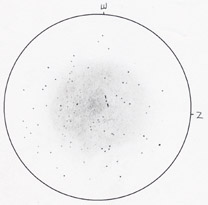 Here's an object that's become a classic challenge for large aperture scopes. Pease 1 is a planetary nebula in M15. It was F. G. Pease who, using observations made with the 100-inch Hooker telescope in 1927 and 1928, first identified this "star" near the heart of the great globular as a planetary nebula. Since the mid-1990's, this challenging object has become a favorite test for owners of large aperture telescopes. The sketch at left combines 452X views with and without an OIII filter in my 18-inch Obsession. The field width is only about 8 arcminutes across so, just the core of the globular is visible. Notice the trapezium grouping of four stars near the bottom of my sketch. This grouping is west of the cluster center by about 2 arcminutes. If you scan east of the trapezium to an area just north of the brightest inner core region, you'll see a crooked line of four stars. Pease 1 resides about halfway between these four stars and the center of M15. The planetary nebula is indicated by hash marks. It was seen with averted vision on consecutive nights at the 2005 Lowell Star Party. Pease 1 appeared to me as the lone bright star in the area when viewed through the OIII filter. This observation was confirmed by several others in attendance at the star party.
Here's an object that's become a classic challenge for large aperture scopes. Pease 1 is a planetary nebula in M15. It was F. G. Pease who, using observations made with the 100-inch Hooker telescope in 1927 and 1928, first identified this "star" near the heart of the great globular as a planetary nebula. Since the mid-1990's, this challenging object has become a favorite test for owners of large aperture telescopes. The sketch at left combines 452X views with and without an OIII filter in my 18-inch Obsession. The field width is only about 8 arcminutes across so, just the core of the globular is visible. Notice the trapezium grouping of four stars near the bottom of my sketch. This grouping is west of the cluster center by about 2 arcminutes. If you scan east of the trapezium to an area just north of the brightest inner core region, you'll see a crooked line of four stars. Pease 1 resides about halfway between these four stars and the center of M15. The planetary nebula is indicated by hash marks. It was seen with averted vision on consecutive nights at the 2005 Lowell Star Party. Pease 1 appeared to me as the lone bright star in the area when viewed through the OIII filter. This observation was confirmed by several others in attendance at the star party. |
![]()
![]()
